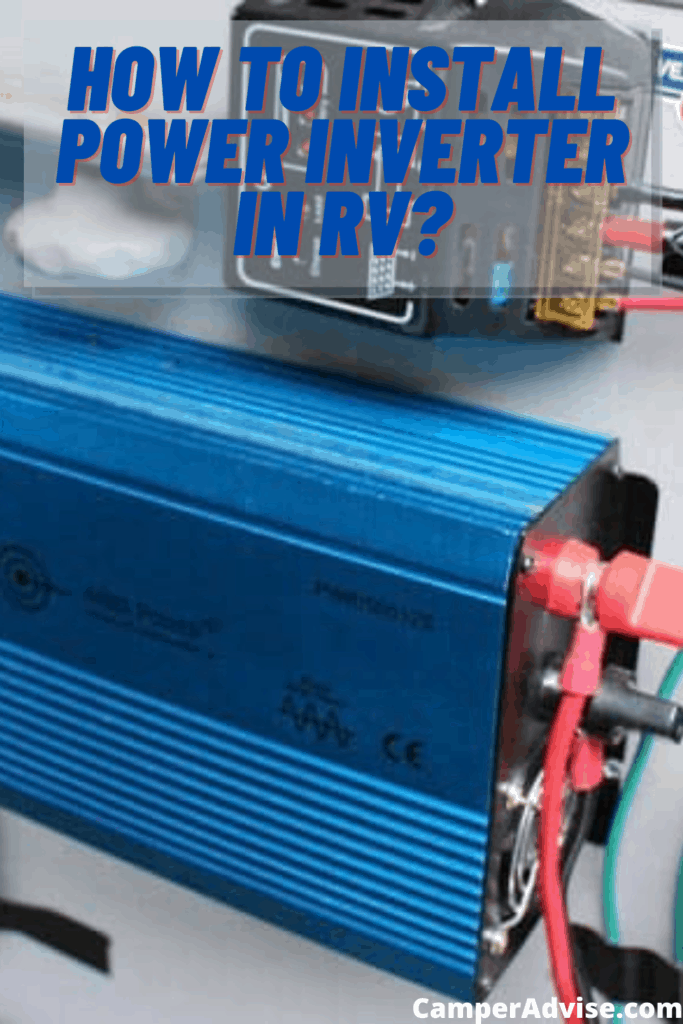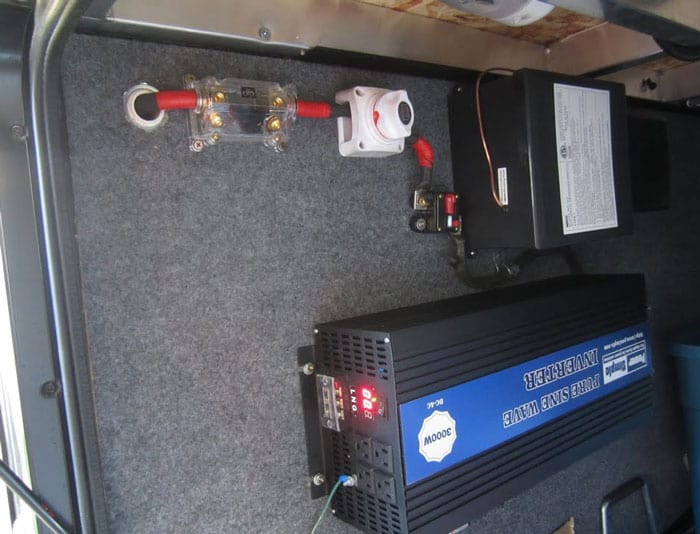Last Updated on December 27, 2020 by Ted Mosby
Although some of the RVs come equipped with a power inverter already installed but not all. If you also have an RV without an inverter and looking to install one, this guide is for you. I will discuss everything related to the RV inverter installation.
Suppose you are a frequent traveler and have a recreational vehicle with no power inverter. In that case, chances are you have already experienced how inconvenient it is to spend nights without electricity in parking or while boondocking because there was no external power source to hook up your rig.
This is where having a power inverter in your RV becomes essential. Installing an RV inverter allows you to stimulate shore power to supply AC power to your entire recreational vehicle when you are traveling off the grid. However, the approach is convenient but dangerous as well if you also have an onboard battery charger.
In that case, it is a must to make sure both (an RV inverter and battery charger) don’t operate simultaneously. Letting the battery charger recharge your batteries while the power inverter is also running could cause severe damage.
So, how to avoid this?
There are three ways to avoid such a situation,
- Installation of a dedicated AC circuit for the power inverter.
- Wiring the battery charger in such a way that it only operates onshore power.
- Using a relay to disconnect the battery charger automatically.
So, how to install a power inverter in an RV?
RV Inverter Installation
Now, if you already have an inverter, you are all set to install it into your recreational vehicle. If you have a smaller one (about 75 watts), you can plug it into a cigarette lighter outlet. But, if you have a larger inverter than this, you will have to wire directly to the batteries.
TIP: The best way to prevent voltage loss is to install the RV inverter as close as possible to the batteries.
Camping Gear SALE!
We have teamed up with Ape Survival to give you a huge 25% off EVERYTHING on their store! They have camping gear, hiking gear, survival gear and much more, all at 25% off when you click the link below.
SHOP NOWSee your inverter manual to determine the size of the wire. I suggest you should use the recommended size or larger. You should also know that the bigger, the larger the wire is, the smaller its gauge number will be. However, the main point is keeping the voltage drop as much as possible. You are required to do everything to keep the voltage loss below 0.075V.
Suppose you cannot find a suitable cable for your RV inverter installation. In that case, you should go for automotive battery cables or jumper cables that are available on the market in 4 to 8 American Wire Gauge.
How to Install RV Power Inverter?
The complicated part during the installation of an RV inverter is when you link the inverter to your RV electrical system. However, before starting the installation process, make sure there is no shore or generator power connected to the inverter’s output.
There are many ways to wire a power inverter, but regardless of what method you are going to use, it is possible to use standard 14AWG wiring. Another point of consideration is to absolutely make sure that the converter is turned off when the inverter is on. This is because if you turn on both inverter and converter simultaneously, you are pulling and pushing the current back into them with inverter and converter, respectively.
As both the inverter and converter are not fully efficient, each trip of current around the loop will waste the power as heat, making you run down the batteries quickly until the inverter shuts off due to low voltage. This could happen even if there is no load connected to it.
1. Method One: Installing Directly to RV AC Box
Although using this method to install an RV inverter is an elegant way, it is the most expensive one as well. You have to link the RV inverter directly to the RV’s AC box using a transfer switch. The transfer switch type depends on the inverter power and whether or not you have a generator.
The switch can automatically detect the shore power if it is available and inverter power if it’s not. Moreover, in this way, make sure not to power the converter through the inverter. In this regard, using a split distribution panel is one way to achieve that.
However, if you think this is a complicated (of course expensive) way, then move to the next method stated below.
2. Method Two: Using Extension Cord
The second method to install an RV power inverter is relatively easy than what we have just discussed above. In this way, you have to run an extension cord from the power inverter to the device you want to supply power at the time. This method is an excellent way for people new to RV inverter installation. However, if you are an experienced RVers, you may get tired of plugging in and unplugging different devices.
3. Method Three: Using Outlets
The third way to install an RV inverter is a bit less crude. You have to connect one or more than one dedicated outlet to the power inverter. You are free to install a new outlet or disconnect the ones already existing in the distribution box.
Camping Gear SALE!
We have teamed up with Ape Survival to give you a huge 25% off EVERYTHING on their store! They have camping gear, hiking gear, survival gear and much more, all at 25% off when you click the link below.
SHOP NOWThe only complication to achieve the RV inverter installation in this way varies where the outlets are situated and if it is hard to wire them. Moreover, using this RV inverter installation method means you have to make sure some outlets don’t operate when connected to shore power.
4. Method Four: Using 30 Amp Receptacle
The fourth and last method to install a travel trailer inverter is to use a 30-amp receptacle on the outer end of your vehicle and then linking it to the output of your RV inverter. When you want to utilize inverter power, just disconnect the shower power and then plug it into the 30-amp receptacle.
As I have stated earlier, that converter and inverter shouldn’t operate at the same time. In this regard, you can take care of this issue by simply flipping the circuit breaker for the converter before you turn on the inverter.
So, how to choose the right inverter?
How to Choose the Right RV Inverter?
Since hundreds of inverters are available on the market, I have narrowed down the list of best RV inverters to choose from. You can read my previous article to get the one that fits your needs.
There are three main points of consideration when getting an RV inverter,
1. RV Inverter Type
An RV inverter is a standalone or integrated model that tends to replace a pre-installed converter/charger in your vehicle with an all-in-one inverter/charger/converter.
If your rig is equipped with an older converter/charger and looking to upgrade it, you should go with an integrated type. On the flip side, a standalone unit is useful if you are considering adding an inverter to a modem multi-stage charging unit capable of handling the size of the battery bank required.
Whatever the case is, the RV installation process will be easier if the unit is equipped with an automatic transfer switch. It makes the 120V system wiring process a whole lot easier.
2. RV Inverter Size
Inverters are sized in wattages of output power and cost accordingly. A 2,000W inverter is capable of supplying up to 2,000W at once, considering there are enough batteries to support it. A standalone wall-mounted unit is rated delivering 15A @ 120V, equating up to 1,800W maximum. Although you can find the wattages and amperages of an inverter on its label, you can also get an idea from available tables online.
Mostly, RVers consider the 1,000 to 2,000W range enough for their power needs. But, if you are looking to power things like laptops and smartphones, you only need 400 to 500W or even less. However, if you are considering to supply power to more things, be clear that a 30 amp RV is only capable of supplying up to 3,600W, while an RV with 50 amp can deliver up to 12,000W.
Again, battery size and cost are the two deciding factors on that.
Watts and Amperage
While estimating the inverter size, you may want to learn some basics of electrical power. Sometimes, you may see specs of an RV inverter in wattages and sometimes in amperes. So, don’t let yourself be confused. Just remember the formula (Watts=Volts x Amperes).
If you see the label saying the device is rated 10A @120V, it merely means it is a 1,200W appliance. Similarly, if the label states it is a 1,200W, it means it needs 10A @120V.
Peaks Vs. Sustained Watts
RV Inverters are rated by both peaks and sustained watts. Remember, the peak is the more significant number, referring to a brief burst of power ranging anywhere between five seconds to a minute (depending on the manufacturer and the model).
While some appliances need extra power to start up, such as microwaves or things having a motor or compressor, such as a refrigerator, if you are considering to power such an appliance, an inverter with a higher peak value will handle the load more effectively.
For your routine power requirements, make sure to get an inverter with high sustained power.
3. Pure Vs. Sine Power
Pure Sine inverters are the best because they are capable of imitating the standard power coming from an electric utility either through shore power or from a generator. While the Modified Sine is the approximation of standard and may some appliances, don’t work correctly.
Some examples of appliances that may not work correctly or not work at all include digital clocks, coffee makers, electric blankets, and things that include motors like blenders and power tools.
Modified sine inverters are outdated technology since they were meant to be a cost-efficient solution. During that time, pure sine inverters were extremely expensive, but over time, modern technology has overcome and narrowed down the cost difference, which means they are now available at a budget-friendly cost.
Remote Switch
If you have bought a new inverter for your travel trailer, chances are you may also have purchased a remote switch for it, which you have to connect to it. These types of switches are generally connected through a telephone cord. However, if you need a longer cord than the one that is already connected to the switch, it may have some resistance to work.
If you have already connected it to a longer cord, but it doesn’t work, you should substitute a cord with heavier gauge wire (18 AWG cable or four-conductor cable).
Wrapping Up
That is all about how to install a power inverter in an RV. An RV inverter allows you to get power even when you are boondocking or traveling off-the-grid. If your rig doesn’t have an inverter already installed to it, you can buy one meeting your needs. The RV inverter installation process is a DIY and straightforward process. You can follow one of the four methods mentioned above to install your new RV inverter. In case of any query, feel free to post a comment below. Happy Traveling
FAQs
Is it safe to leave the RV inverter on all the time?
Leaving your RV inverter on all the time means it will deliver continuity of power. You should have the Auto Gen Start feature activated to avoid power loss. It will also make sure your RV batteries are drained only to a safe level and get recharged on-time.
How to mount an RV inverter?
When mounting an RV inverter, make sure to mount it either as horizontally on a vertical surface or on a horizontal surface.
Table of Contents


